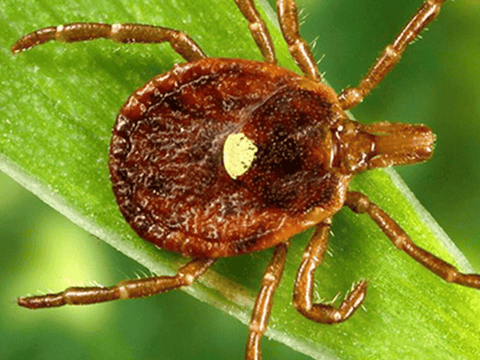Alfa-Gal Allergy

Tick borne disease: Alfa-gal allergy
Also known as: Alfa-gal syndrome, mammalian meat allergy
Disease Agent: Alfa-gal sugar molecule
Infectious Bite Time: While most tick bourne disease transfer requires a sustained bite time of 24 hours or more, ticks may be able to transmit Alfa-gal allergy rather quickly, within an hour of the initial bite.
Incubation Period: Impacts of alpha-gal allergy can begin fast, with onset within the first few hours after you are infected by a biting tick.
Common Signs and Symptoms: Alpha-gal allergy symptoms occur when you eat red meat, a truly horrifying situation for meat lovers. Symptoms usually being within a few hours of meat consumption. Symptoms include a runny nose, hives, itchy skin, scaly skin, wheezing, sneezing, and headaches. Once you have contracted alfa-gal syndrome there is an exceptionally good chance you will need to cross red meat off your edibles list, for life. Symptoms are like what any individual with a food allergy would experience if they were to eat what they are allergic to. Alfa-gal meat allergy symptoms are not exclusively triggered by the consumption of red meat, there have been documented cases of symptoms manifesting continually, regardless of diet.
Serious Complications: anaphylaxis (restricted breathing), swelling of the throat, sudden blood pressure drop, rapid pulse, extreme dizziness. Anaphylaxis can also occur, sometimes suddenly. Seek immediate medical attention if you experience the following anaphylaxis symptoms: difficulty breathing, drooling, inability to swallow, swollen throat, full body redness and warmth, rapid weak pulse
Treatment Options: While there is no known cure for alfa-gal allergy, there have been cases where the condition went away on its own after a few years. Seek the assistance of heath care providers, they will be able to help and may recommend you carry an epinephrine autoinjector, for emergency, if you accidentally consume meat. You need only to consume a trace amount of red meat to suffer a severe reaction, use great caution in choosing meals. If you believe you have contracted alfa-gal allergy consult a medical professional, early diagnosis is essential to preventing serious complications, delaying treatment can make a bad situation worse, resulting in escalated symptom severity or even death.
Notes and Facts: Alfa-gal allergy is a serious and potentially life-threatening condition. Alfa-gal allergy is one of the most terrifying true tick threats, one that many are unaware of. Alfa-gal allergy corelates strongly with the habitat of its primary vector, the lone star tick, a tick found in the Eastern, Midwestern, and Southern United States. If you know anyone hesitant to use tick repellent, someone that loves steak or red meats of any kind, tell them about alfa-gal. One bite from the wrong tick and that could be it for them, no more meat for life. The cruel irony of alpha-gal is the lone star tick has a heavy population in Texas, Texans are famous for their red meat affinity. You cannot simply look at a tick and determine if it carries alfa-gal allergy, if a tick is attached to you learn how to remove a tick and keep the tick, it can be tested for alpha-gal. Use Tick Proof to prevent future attacks.
What ticks transmit Alfa gal? Lone star tick, paralysis tick (Australia)
Primary Vector: Lone star tick
Number of infections per year, United States: 5000+
The Lone star tick (below) transmits Alfa-gal allergy.

